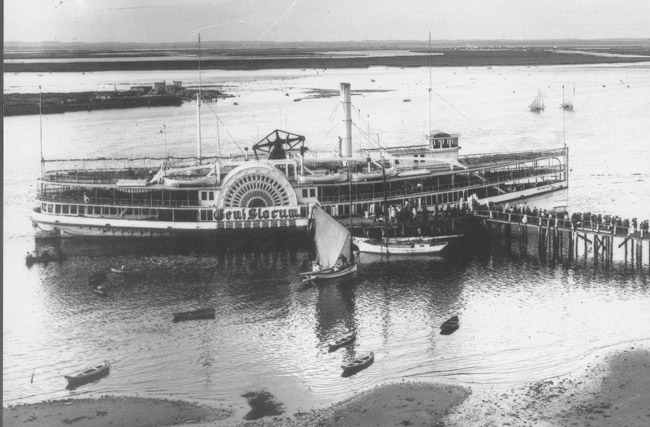
paddlesteamers.info : The Internet's leading website for Side-Wheeled Paddle Steamers

In earlier years, steamboating could be very hazardous. Not only were coasts and waterways treacherous and not always well charted, wooden built ships with rudimentary steam engines and boilers, fires to heat the saloons and a range of potentially combustible cargoes, became a persistent fire hazard. Many were lost this way, sometimes with significant loss of life. Many ywere also lost, sometimes mysteriously, as a result of fires during winter lay-ups and in the country's interior, crushing winter ice regularly accounted for wooden ships. It was not until the 1880s that iron hulls became more common and the 1890s when steel slowly began to appear. Even in latter years, wood was used for ships' superstructures and was one of reasons why some vessels, when being scrapped, were burnt out first. Many ships were left abandoned to deteriorate on coasts or riverbanks and sunken wrecks were rarely raised.
Wood was, of course, in plentiful supply in the vast undeveloped interiors away from the main cities, so as well as being cheap it was easy to work with using traditional skills. Iron and latterly steel was in short supply and expensive. As ships grew in size and the machinery installed ever heavier, wooden framing became increaingly problematic and ingenious solutions were developed to strengthen the hulls. Arched tensioning beams over much of the length of the ship, known as hogging trusses, became a common and characteristically noticeable feature which distinguised paddlers in the Americas from their European counterparts.

Above : The arched "hogging truss" can be seen clearly on New York City's excursion ferry General Slocum. Noticeable as well are the extremely large paddle wheel boxes and the upper parts of the vertically-operating beam engine. All three differentiated paddle steamer design in North America from that of Europe
Rivers into the interior were also often hazardous to navigate and many were strewn with wrecks with those of some paddle steamers still existing today. Coastal sea conditions could be atrocious in winter and such difficulties affected the Great Lakes, especially the larger Lakes Michigan and Superior with particularly severe winters. Ice could be a real problem, especially for wooden-hulled ships. Even in sheltered coastal waters such as Long Island Sound, weather conditions can become extremely aggressive and in the days of wooden ships and often a carefree attitude to safety, numerous tragedies occurred.
Paddle steamers in North America took on a different design from those in Europe and appeared noticeably different in most instances. The persistence with wooden hulls has been noted, but the affection for the simple, one-cylinder, vertically installed Beam Engine led to to notable characteristics. The Beam Engine was a steam engine in its simplest form only little changed from the earliest water-pumping engines of the era of pioneering engineer James Watt. Cheap, even if not particularly economical, the piston stroke was typically 144 inches (12 feet) and the cylinder diameter 60 inches (5 feet). Being installed vertically, the associated equipment and swinging metal "walking beam" necessarily poked out of the top of the ship and visibly above any upper passenger promenade deck. The beam engine's extremely slow movements led to a low revolution rate on the paddle wheel, so in order to get sufficient propulsion, the wheels themselves had to be massive in size, although the development of feathering mechanisms allowed smaller wheels. Remarkably, beam engines continued to be fitted into paddle steamers in the early part of the 20th century, with the massive "night boats" of the River Hudson being examples, with their Trojan and Rensselaer being built in 1909. It was not unusual for new ships, even high presige vessels, to inherit the engine of a much older withdrawn or even sunken ship. One notable example was the Hudson River Day Line's Robert Fulton of 1909 which used engines from 1887 recoved from sunken fleet-mate New York although. The company had progressed to compound diagonal engines for its Hendrick Hudson of 1906 and only the company's last paddler, Alexander Hamilton of 1924, had a triple diagonal engine installed. The Great Lakes leviathans designed by Frank E Kirby latterly employed three-cylinder compound engines with the high pressure cylinder exhausing to two equal-sized low pressure cylinders.
The story of steamboating was a complicated but fascinating one. A free-for-all of aspiring owners all trying to make a living in the New World and the growing power of industrial magnates led to the proliferation of operators and frequent consolidations and corporate take-overs, over-expansion, cut-throat competition, some questionable business dealings on occasion and bankruptcies. Closely associated with the development of the railways, steamboat services were a forerunner of the railway mania which was to follow. The quest to be the best on the waters and keep business from the railways led to the construction of the largest and finest paddle steamers the world had ever seen. Whilst initially successful, it was not to last. Fares had to remain competitively low and the expansion of the road system and motor car usage was the final nail in the coffin
Various artefacts have been saved from scrapped ships, including interior fittings and some machinery in museums. The only complete traditional paddle steamer still in existence is Ticonderoga, which sailed on Lake Champlain, which is preserved on dry land as an exhibit at a museum at Shelburne
Photo
: Ticonderoga, built in 1906 and in service on Lake Champlain, Vermont, until 1953, seen in 2011.
By kind courtesy of "storylanding" on wikicommons and placed in
the public domain
New York City, Coney Island and Northern New Jersey Coast
Long Island Sound and North Eastern Seaboard
Lakes of Northeastern USASouth East Coast and Gulf of Mexico